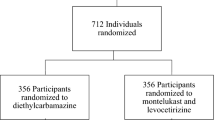Summary
Cetirizine 2.5mg or 5mg twice daily was compared with placebo over a 2-week period in a multicentre double-blind parallel group study in 138 (3 groups of 46) children aged 2 to 14 years with perennial allergic rhinitis.
The principal symptoms of allergic rhinitis including nasal obstruction, nonpurulent rhinorrhoea, nasal pruritus, sneezing and pharyngeal drip were chosen for the evaluation of efficacy. In addition, sore throat, conjunctival erythema, lacrimation and ocular pruritus were also evaluated. Each symptom was assessed by investigators using a scale from 0 = ‘none’ to 4 = ‘Very severe’ and requiring additional medication for control. Parents and patients were asked to record symptom severity on a scale of 0 (none) to 3 (severe) and any adverse events on a daily basis. Tolerability was assessed by means of reported adverse events, together with the results of routine clinical laboratory tests performed before and after treatment.
Patients receiving cetirizine 10mg daily had a significantly greater improvement in symptoms of perennial allergic rhinitis than patients on placebo as assessed by average symptom scores and investigators’ global evaluation of efficacy. In addition, cetirizine 10 mg/day produced a significantly greater improvement in the symptoms of nasal obstruction and rhinorrhoea than either cetirizine 5 mg/day or placebo. Parents’ evaluations also favoured cetirizine 10 mg/day ahead of both cetirizine 5 mg/day and placebo.
Cetirizine was well tolerated. No patient withdrew from treatment because of an adverse event; furthermore, mild sedation was only occasionally reported.
Similar content being viewed by others
References
Berman BA. Perennial allergic rhinitis: clinical efficacy of a new antihistamine. Journal of Allergy and Clinical Immunology 86: 1004–1008, 1990
Broide DH. Evaluation of cetirizine in the treatment of patients with seasonal allergic rhinitis. Abstract No. 31. Journal of Allergy and Clinical Immunology 1: 176, 1988
Charpin D, Birnbaum J, Pirson F, Vervloet D. Comparative double blind study of cetirizine and astemizole in the treatment of seasonal allergic rhinitis. Abstract No. 397. Journal of Allergy and Clinical Immunology 85: 243, 1990
Juhlin L. Cetirizine in the treatment of chronic urticaria. Clinical Therapeutics 13: 81–86, 1991
Levander S, Stahle-Backdahl M, Hagermark O. Peripheral antihistamine and central sedative effects of single and continuous oral doses of cetirizine and hydroxyzine. European Journal of Clinical Pharmacology 41: 435–439, 1991
Meitzer EO. Comparative safety of H1 antihistamines. Annals of Allergy 67: 625–633, 1991
Monroe EW. The role of antihistamines in the treatment of chronic urticaria. Journal of Allergy and Clinical Immunology 86: 662–665, 1990
Sabbah A. Comparison of cetirizine and terfenadine in perennial allergic rhinitis. Abstract No. 43. Allergologia e Immunologia Clinica 212: 322, 1987
Author information
Authors and Affiliations
Rights and permissions
About this article
Cite this article
Baelde, Y., Dupont, P. Cetirizine in Children with Chronic Allergic Rhinitis. Drug Invest 4, 466–472 (1992). https://doi.org/10.1007/BF03259210
Published:
Issue Date:
DOI: https://doi.org/10.1007/BF03259210




